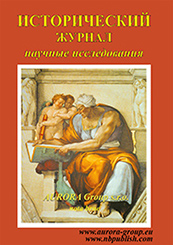QUANTITATIVE METHODS IN HISTORY, HISTORICAL INFORMATICS
Reference:
I. V. Shilnikova (2014). Labor disputes and workers’ economic
condition in Russian textile factories
during the years of World War I:
an analysis of the archival material. History magazine - researches, 3, 243–254. https://en.nbpublish.com/library_read_article.php?id=65795
Abstract:
Keeping social peace and preventing complex, lengthy labor conflicts in factories during the years of World War
I became one of the crucial priorities of the owners and managers of industrial companies. Many of them were willing within
reason to meet the demands of the workers on improving their economic situation. In the first place, the article exposes how the
workers’ demands, put forward individually or during strikes, were influencing the entrepreneurs and factory administrators’
decisions to increase work wages and narrow its differentiation level. Secondly, the author examines which complementary
measures were undertaken by the managers in order to provide the workers with items of first necessity in case of the prolongation
of the war. Thirdly, the article determines the level of differentiation in textile workers’ wages in two periods of time (June
1914 and June 1916) to define how much this indicator changed during two years of war based on workers’ qualification
level (profession), age category (adults, adolescents, children), and gender. This research is founded on archival material,
which permits to analyze labor conflicts and workers’ economic condition during the years of World War I on a micro level (in a series of individual companies). As well, this study uses statistical methods (including the correlational analysis). The
article demonstrates how under the influence of workers’ demands there was an increase in their wages and a decrease in their
differentiation during World War I. During these years, the welfare policy of enterprises, beside wage increases in correlation to
costs of living, included other elements, some of which proved effective and were consequently adopted by the government which
sought to develop efficient measures for keeping order and discipline in industrial companies – a particularly critical issue in
a time of war.
Keywords:
labor conflicts, textile-workers, World War I, workers’ economic condition, differentiation of work wages, correlation index, strikes, enterprise social welfare, factory shop, workers’ demands.
HISTORIOGRAPHY AND SOURCE STUDIES
Reference:
P. A. Plyutto (2014). The testament of N. B. Yusupov –
the Younger. History magazine - researches, 3, 255–269. https://en.nbpublish.com/library_read_article.php?id=65796
Abstract:
This article (publishing a historical source) demonstrates on the example of an analysis of a specific juridical
document the importance of scientific research of any historic juridical source, even when the source seems at first of little
informational value and trivial. The scrupulous analysis of the testament of N.B. Yusupov-the Younger, is valuable in
that it exposes precise – judicially verified – minute details of his biography, which complement and correct already known
facts derived from other, private sources. The author analyses the named historical source, exposes little known historical
facts, consolidates them with other historical facts drawn from other sources, and depicts a consistent historical picture.
The value of the testament for source study comes from that it in itself sums up the life and activity of that historical figure,
being tied, even if not always noticeably, to numerous seemingly unrelated documents. Through the process of exposing these
ties and their enrichment with concrete facts of life, the author reveals a complete historical picture – which is the aim of
any source study research.
Keywords:
testament, house of Yusupovs, N.B. Yusupov-the Elder, N.B. Yusupov-the Younger, T.A. Yusupova, Z.N. Yusupova, Golitsyn princes, Alexander II, reforms, liberalism, Archangelskoe estate.
HISTORIOGRAPHY AND SOURCE STUDIES
Reference:
I. M. Pushkareva (2014). The workers’ protest movement
in Russia in the years of World War I
(reading the book of Y. I. Kiryanov). History magazine - researches, 3, 270–284. https://en.nbpublish.com/library_read_article.php?id=65797
Abstract:
The article analyzes the book of Y. I. Kiryanov on the labor movement in Russia during the years of
World War I. The author examines the historiography of the given question and details the context of the question,
which was significantly altered after the publication of Y. I. Kiryanov’s book. Many questions on the history of
the labor movement that were considered to be well-studied, received new light through Y. I. Kiryanov’s research.
Y. I. Kiryanov thoroughly verified the data of the sources on which the post-Revolution historiography based the
study of this question and convincingly showed the need to corroborate many enduring in historical science conclusions
regarding the labor movement of the pre-Revolution era. The author discusses the book of Y. I. Kiryanov based
on the results of his own research of this topic, which have been reflected in several works. The article gives special
attention to a debate with the newest works on the history of World War I and the February revolution, the authors
of which touch upon the question of the labor movement. According to the author, these scholars are not giving due
attention to a whole arra y of social aspects of the mass-pr otest movements in the y ears of the World War I.
Keywords:
World War I, February revolution, State duma, labor movement, strikes, protest, historiography, Bolsheviks, Mensheviks, food supply crisis.
Archeology
Reference:
A. R. Kantorovich (2014). Syncretic figures in Eastern-European
Scythian zoomorphic style art: statistics
and general iconographic trends. History magazine - researches, 3, 285–306. https://en.nbpublish.com/library_read_article.php?id=65798
Abstract:
The Scythian-Siberian zoomorphic style from the VIIth – beginning of the IIIrd century B. C., being part of the “Scythian
triad” along with armor and horse equipment, presents a particular artistic direction of applied zoomorphic art, characterized
by a stable set of animal figures depicted in strictly defined poses and compositions, and using special detail modelling techniques.
Some of the most important elements of this repertory are the syncretic figures: griffins and other zoomorphic creatures formed from
different elements of real animals in fantastic combinations. This article is based on a study of a wide array of syncretic figures
(201 objects in original, not including copies) made in Eastern European Scythian animal style, correlated with the region of
Scythian archaeological culture and being one of the local variants of the Scythian-Siberian zoomorphic style. The author presents
the main results of an image-figurative classification, subject-stylistic typology and statistical analysis of the mega-form of syncretic
(fantastic) animals. The research shows that the figures of syncretic animals compose almost a tenth of the whole set of original
figures of Eastern European Scythian animal style. Compared to the three other Scythian animal mega-forms – birds, hoofed and
predatory animals – syncretic creatures had less morphological standardization and calibration for stylistic elaboration. The basis
for the mega-form of syncretic creatures consists of figures of Early and Late Greek-type griffins and their local modifications. The
theme of the griffin, which came into Scythian art through Ancient Greek and Near Eastern (Assyrian-Urartian, Hittite, and,
later, Achaemenid) art, in its bare form was not enough popular in the Scythian culture and was often replaced with a similar, yet
not identical syncretic figures, clearly, corresponding better to the local ideology.
Keywords:
archaeology, Scythian animal art style, Scythian archaeological culture, history of Scythian art, repertory, syncretic figures, griffin, figural statistics, iconographical classification.
Historical facts, events, phenomena
Reference:
N. I. Kharitonova (2014). Bessarabia and Pridnestrovie after
the events of the Russo-Turkish war
of 1806–1812. History magazine - researches, 3, 307–312. https://en.nbpublish.com/library_read_article.php?id=65799
Abstract:
The article analyzes the particularities of the period in the history of Bessarabia and Prednistrovie after the
events of the Russo-Turkish war of 1806–1812 and until the beginning of the XXth century, and assesses the importance
of the Treaty of Bucharest, in accordance with which Bessarabia was joined to the Russian empire based on the outcome
of the military confrontations. The terms of the Treaty of Bucharest were important for the population of the region,
because had Bessarabia in 1812 remained under the rule of the Ottoman Empire, then at the end of the XIXth century
it would have become, along with the rest of historic Moldavia, part of the Romanian state. The modest autonomous
beginnings and especially the privileges, which were accorded to Bessarabia by Russia in 1812––1818 and prescribed
in the Statute of 1813 and in the Articles of 1818, had a positive effect on the economic development of the region, on
its population settlement. The analysis of the socio-economic and ethnic processes in the Dniestr basin, on the basis of
published sources and periodicals, clearly indicates a positive influence from the unification of Bessarabia to Russia, to
the formation of a historic region with its own patterns of political, social and economic development, and to a dialogue
of traditions and cultures between different ethnic groups. The joining of Bessarabia to Russia had an extremely important
meaning for the region, which in this period had experienced political, socio-economic, demographic and cultural
transformations, differently interpreted by historians. The author comes to the conclusion that the development of the
region did not cause contestation, including on the ethnic ground.
Keywords:
Ottoman empire, Pridnestrovie, Moldavia, Bessarabia, Russian empire, Russia, ethnicity, identity, moldavophilism, roumanism.
Beliefs, religions, churches
Reference:
T. G. Skorokhodova (2014). The Ramakrishna Paramahamsa
phenomenon and the formation
of neo-Hinduism in Bengal. History magazine - researches, 3, 313–323. https://en.nbpublish.com/library_read_article.php?id=65800
Abstract:
The article presents the Bengali prophet Ramakrishna Paramahamsa (1836–1886) as a phenomenon of a
religiously gifted personality, which from his faith and unique mystical experience came to found a particularly heterodox
and contemporary reinterpretation of Hinduism. The phenomenon of Ramakrishna is accordingly placed in its context of
the transformation of the traditional society in colonial India, and in the peripheries – Bengal, where existed for centuries
an heterodox interpretation of dharma and thus concurrently formed a space of dialogue between the West and India in
Calcutta. The research is based on the hermeneutical analysis method of the sayings of and conversations with Ramakrishna
in a general cultural context of the intellectual pursuits during the period of the Bengal Renaissance. The article
shows that the image of Hinduism as a religion by Ramakrishna, leading all followers on different paths towards the single
God, reconciles orthodox and heterodox, Brahmanic and “popular” beliefs and becomes the basis for the development of neo-
Hinduism as a way of thinking and a religious practice at the turn of the XXth century.
Keywords:
history of neo-Hinduism, image of Hinduism, the Bengal Renaissance, traditional prophet, Vaishnavism, religious experience, heterodoxy, paths towards God, Jnana, Karma, Bhakti, religious ethics.
Civilizational approach and civilizational commonality
Reference:
D. V. Molchanov (2014). On the question of adaptation
of Western cultural values in Russia. History magazine - researches, 3, 324–330. https://en.nbpublish.com/library_read_article.php?id=65801
Abstract:
The article examines the question of adoption and incorporation of Western development models into Russian
culture from the point of view of the adaptability of basic global national-cultural values. The author compares the
values predominant in one or another area of the political map of the world and, based on that, analyzes the polysemantic
perception of patriotism in modern Russian culture. The article separately studies the conflict and division of values
that exist in contemporary Russian society and on the basis of that outlook comes to the conclusion of the impossibility of
its forward development in the framework of ideological monism. The author analyzes the concepts of renowned Western
scholars, who stated and developed the civilizational approach in their works. As well, the author gives a new interpretation
of the old cultural-civilizational debate between the Slavophils and the Westernists in the light of the current state
of civilization development. The author explains why this old debate has found today a new voice, construes its modern
emphasis, and illustrates the complex and contradictory process of entailing this discussion with all the previous development
of Russian history.
Keywords:
national-cultural values, cultural dialogue, clash of civilizations, traditions, reforms, freedom, patriotism, Russia, values, the West.
History of state and law
Reference:
I. A. Gvozdeva (2014). Land law in the judicial composition of
emperor Augustus’ cadastral survey. History magazine - researches, 3, 331–343. https://en.nbpublish.com/library_read_article.php?id=65802
Abstract:
The aim of this research is to study the developmental particularities of the Roman Land law, which
defined the social life of Roman society from the Kingdom until the beginning of the Empire. More precisely, the
article aims to expose the mechanism of the judicial process, which reflected the development of this branch of the Ius
Civile. The basis for this research is the key source on land surveying and judicial procedures in land exploitation
of Rome – the body of treatises written by Roman land surveyors (Corpus agrimensorum romanorum). However, this
exceptional monument has not been sufficiently used by Russian and foreign scholars of Ancient Rome. The study
of the judicial proceedings on land law is usually based on the works of classical jurists, which rather reflect the later
stages of its development. Meanwhile in the Corpus agrimensorum, specialists of the Roman land law point to the
long preservation of archaic forms of conducting legal processes, which August also included in the cadastral system.
This raises a question: why in an optimal land survey system that precisely identified the position of ownership and
possession were continued to be included methods of the previous ancient judicial process? A particularity of the
Roman economy was the early registration of land ownership, established in the Ius Quiritium. These possessori
existed during the whole period of the Republic, despite attempts of reorganization and the conservation of the judicial
process. This is why the controversia de fine – the debate on natural boundaries – remained crucially important in land law and for a long time preserved clauses for pleadings. These clauses were also preserved by other delimitation legal
claims: de rigore, de positione terminorum and what is more important, the controversia of the “on territory” – de loco,
because they are all devoted to ownership relations. Ius Honorarium significantly contributed to the separation of ownership
trials from delimitation suits. But even in the controversia of de modo, de possessione beside clearly defined propriety interest,
were also preserved delimitation clauses. Without their full analysis it would have been impossible to come to a just verdict.
This is why in the period of the praetorian law the judicial process established the adiudicatio (adjudgement), which led
to a conflict resolution compromise that ensured social order. August also created a special law Ius Subsecivorum (law of
segments), devoted to the judicial destiny of segments left from land surveyed fields. It was precisely on these segments of land
that propriety disputes arose in cadasters, which were reflected in the controversia of delimitational character with attributes
of the archaic judicial processes. This is why the preservation of ancient forms of judicial proceedings allowed full use of the
possibilities of different land categories in a familiar for the Roman legal consciousness formulation. And this is precisely
what defined the formation of the land law into a separate branch of the Ius Civile.
Keywords:
controversia, judicial process, land surveyors, expertise, praetorian formula, adiudicatio, border, land ownership, August, Ius Honorarium.
ECONOMIC HISTORY, ENTERPRENEURIAL HISTORY
Reference:
A. A. Bikina (2014). The production of butter in Western
Siberia at the beginning of the
XXth century: development factors,
the role of the Union of Siberian
butter-making cooperatives. History magazine - researches, 3, 344–356. https://en.nbpublish.com/library_read_article.php?id=65803
Abstract:
This article examines the formation process of entrepreneurial structures in Western Siberian butter production
– a region where this food industry sector started developing only in the 1890s, but then rapidly expanded
at the beginning of the XXth century, so as to compare in volume to the butter production in the Vologda region, and
even to surpass it. The author shows the significant role played by the butter-making cooperatives in the Siberian
butter production, and the aims of the conventions of butter manufacturers and butter exporters in Siberian butter
sales and exports. The research is based on the methods of comparative and typological analysis, primary statistical
processing, and the visualization of tabular data. However, the author does not yet attempt a detail look into the
activity of the conventions of the Union of Siberian butter-making cooperatives. Particular attention is given to the
Union’s displacement of foreign firms – exporters of Siberian butter, the formation of larger butter-making cooperatives
– producers of butter, and their negotiations of interests on a contractual basis. The institutionalization of this
process began during the years of Stolypin’s reforms. The author demonstrates how the development of large cooperative
production, the creation of the Union of Siberian butter-making cooperatives, the activity of the conventions of
butter exporters and producers of the dairy industry, all contributed to the balancing of interests of thousands of
cooperatives, butter-making factories, to the raised level of production quality, and to the increased coordination role
of this cooperative organization, especially in the sphere of distribution of the Siberian butter-makers products to the
main markets of consumption.
Keywords:
Western Siberia, butter production, cooperatives, Union butter-making cooperatives, Convention of butter exporters, A. N. Balakshin, cooperative butter-making association, Av. A. Kalantar, cooperative stores, V. O. Sokulsky.
REVIEWS, BIBLIOGRAPHY
Reference:
S. V. Kretinin (2014). Book review: März, Peter. After
the resulting catastrophe. Germany,
Europe and the First World War.
Böhlau Publishing: Cologne,
Weimar, Vienna, 2014. 295 p.
(März, Peter. Nach der Urkatastrophe:
Deutschland, Europa und der Erste
Weltkrieg. Böhlau: Köln, Weimar,
Wien, 2014. 295 s.). History magazine - researches, 3, 357–359. https://en.nbpublish.com/library_read_article.php?id=65804
Abstract:
The article presents a review of the new book by the German historian Peter März, a recognized specialist in
the history of World War I. His work is predicated on the basic idea of the interrelation and continuity of European history
between the modern and the contemporary times. The starting point is set with the Peace of Westphalia of 1648, which
ended the first pan-European war. The next important time mark is the end of the War of the Spanish succession and the
Peace of Utrecht of 1714. According to März, the established system of international relations continued until the period
of the Revolution and Napoleonic France. In 1815 began a new chapter of European history resulting from the decisions
of the Vienna congress. The author considers that the Treaty of Versailles of 1919 determined the shape of Europe in the
XXth century until the events of 1990: the end of the Cold war and the collapse of the Communist regimes. The structure of
the reviewed book combines chapters both traditional for a general work on the history of World War I, as well as methodologically
innovative sections. The book presents a prominent general research on the history of World War I and its
consequences for Europe on the whole, and Germany in particular. On the basis of modern publications, the author draws
a striking picture of the global catastrophe of 1914-1918. Among the undeniable merits of this book are its limpidity in the
written language and the clearly identified methodological accents.
Keywords:
World War I, historiography, Treaty of Versailles (1919), German history, Germano-russo-polish relations, Russian history, Weimar Germany, World War II, Cold war, Pan-Germanism idea.
 This work is licensed under a Creative Commons Attribution-NonCommercial 4.0 International License.
This work is licensed under a Creative Commons Attribution-NonCommercial 4.0 International License.
 Eng
Eng












 © 1998 – 2025 Nota Bene. Publishing Technologies. NB-Media Ltd.
© 1998 – 2025 Nota Bene. Publishing Technologies. NB-Media Ltd.




